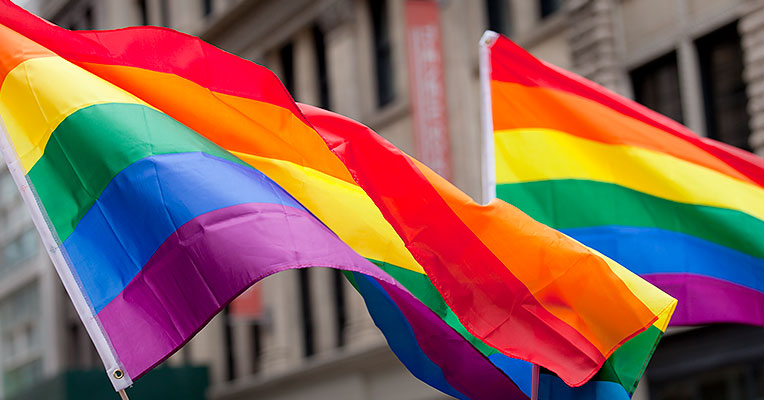LGBTQ+ individuals and couples are building their families more now than ever before. That’s in part because of the many options available for LGBTQ+ family building. Reciprocal IVF, adoption, and surrogacy are just a few. However, stigma and restrictive policies still prevent access to the care needed for LGBTQ+ people to start their family.
In fact, “patients who deviate from the heteronormative family have historically been denied access to assisted reproductive technology (ART).”
Though we still have work to do, the Stonewall Riots of 1969 sparked monumental changes for the LGBTQ+ community. This year, we’re celebrating the 52th anniversary of the New York City Pride march by remembering important dates in LGBTQ+ history.
Important Dates in LGBTQ+ Family Building History
1969: The Stonewall Riots began when police raided a gay bar in Greenwich Village.
The raid sparked a movement that is still going strong 51 years later.
1970: The first ever Pride march to commemorate the Stonewall Riots.
The first ever Pride march began in New York. It inspired other cities like San Francisco and Los Angeles to do the same.
1978: New York state won’t reject adoption applicants for their sexuality.
New York is the first state to take this stance. Others will later follow suit.
1979: 200,000 marched in Washington D.C for Lesbian and Gay Rights.
For the first time, smaller LGBTQ+ groups and organizations were able to unite together. It was the largest demonstration for LGBTQ+ rights to date.
1982: The Sperm Bank of California opens.
The Sperm Bank of California is the first to support lesbian and single women who want to have children.
1984: The city of Berkeley in California is the first to offer domestic partnership benefits for their employees.
It was a means to offer benefits to couples who aren’t married, ultimately helping same-sex couples who legally couldn’t at the time.
1985: A gestational surrogate successfully delivers a genetically-unrelated child.
Although the couple was dealing with infertility issues, surrogacy opened up doors for same-sex couples wanting to have children.
1987: The American Psychiatric Association removes homosexuality from their list of disorders.
The APA actually changed “homosexuality” to “sexual orientation disturbance” in 1973, but finally repealed all mention of sexual orientation in 1987.
1999: For the first time, a gay couple was on their child’s birth certificate.
They were legally recognized as parents of their child.
2007: The House of Reps signed a bill that demands equal rights in the workplace.
It was specifically helping gay, lesbian, and bisexual people.
2008: California Supreme Court rules that providers can’t deny access to fertility treatments due to the patient’s sexual orientation.
Guadalupe “Lupita” Benitez won the case against the North Coast Women’s Care Medical Group. California’s Supreme Court held that the NCWCMG couldn’t deny Benitez of fertility treatments based on sexuality. Benitez has had 3 children since the case.
2008: New York State votes same-sex marriages valid in other states are to be recognized by New York employers.
This gave gives marriage rights to all same-sex couples in New York who were married out-of-state.
2009: President Obama signs a referendum that provides federal employees and their same-sex partners health benefits.
Although an important step toward equal rights, it still didn’t provide the partner with full healthcare coverage.
2010: President Obama rewrites hospital visitation rules to designate visitors.
Patients are now able to designate specific visitors regardless of marital status, ultimately helping same-sex couples whose marriage may not be recognized under the law.
2011: The U.S State Department updates passport applications.
The update gave “Parent 1″ and “Parent 2” options, opposed to the original, “Mother and Father.” The change recognizes all families.
2015: Obergefell v. Hodges rules same-sex marriage as legal under the U.S Supreme Court.
A monumental case this century, it allowed same-sex couples countless rights they didn’t have prior. Among them, many couples were able to start their family.
2016: The World Health Organization updates the definition of infertility.
Now, same-sex couples and single parents by choice are included in the definition.
2016: Progyny launches nation’s first comprehensive fertility benefits solution accessible to all.
Progyny’s family-building benefits solution allows members, regardless of sexuality, gender, and marital status, access to fertility coverage.
2018: The Family Equality Council started the LGBTQ Family Building Survey.
It’s a comprehensive research study commissioned to understand the landscape for LGBTQ adults. For 2019, it reported that the number of LGBTQ families are set to grow dramatically. And, that the gap between LGBTQ and non-LGBTQ parenthood rates is decreasing.
To learn more about LGBTQ+ family building watch this webinar and explore these resources.
